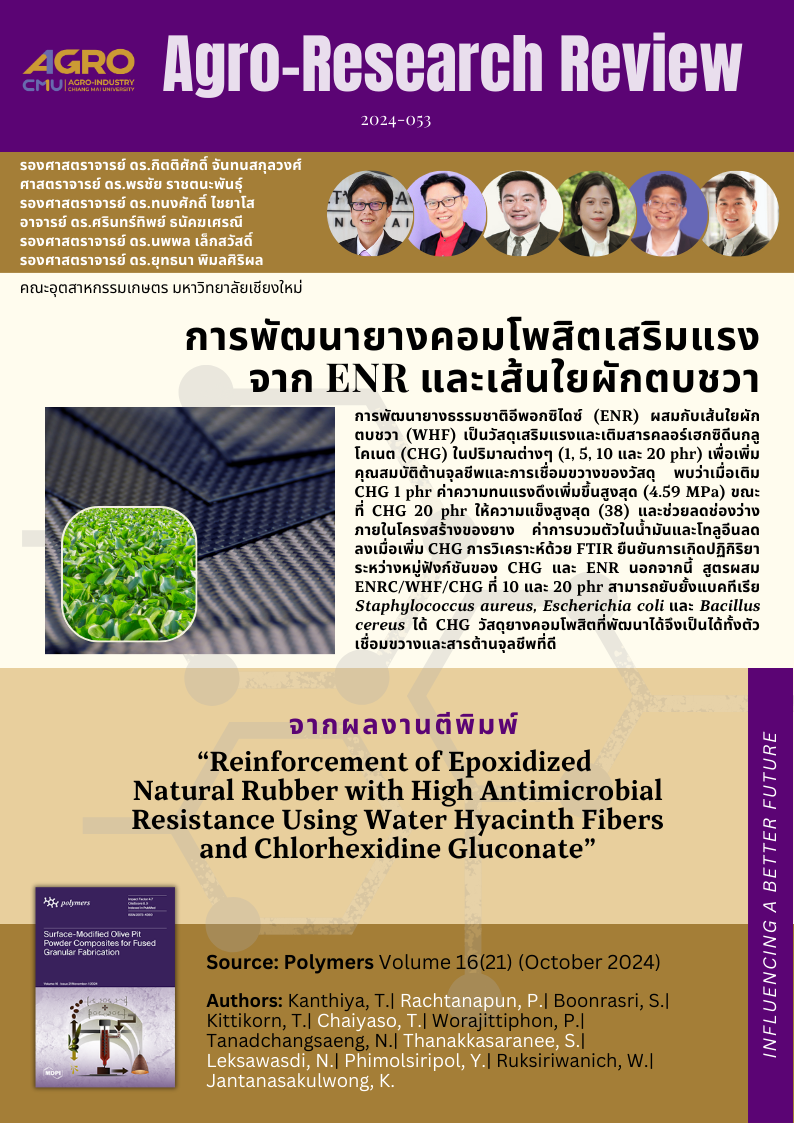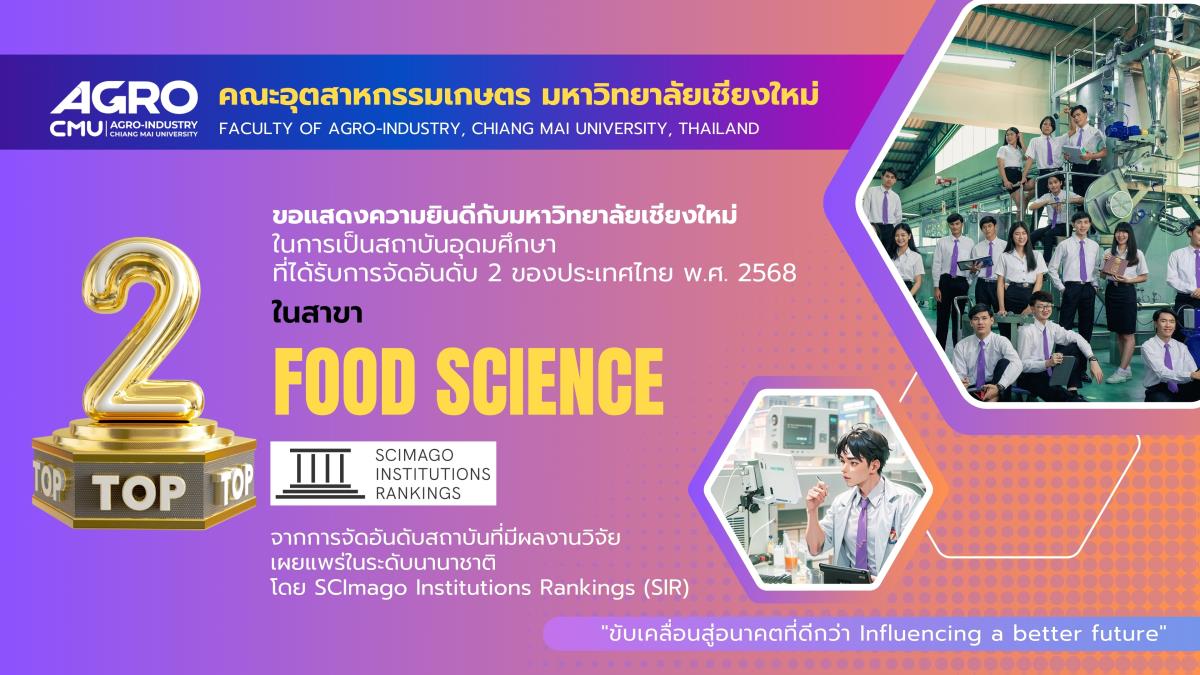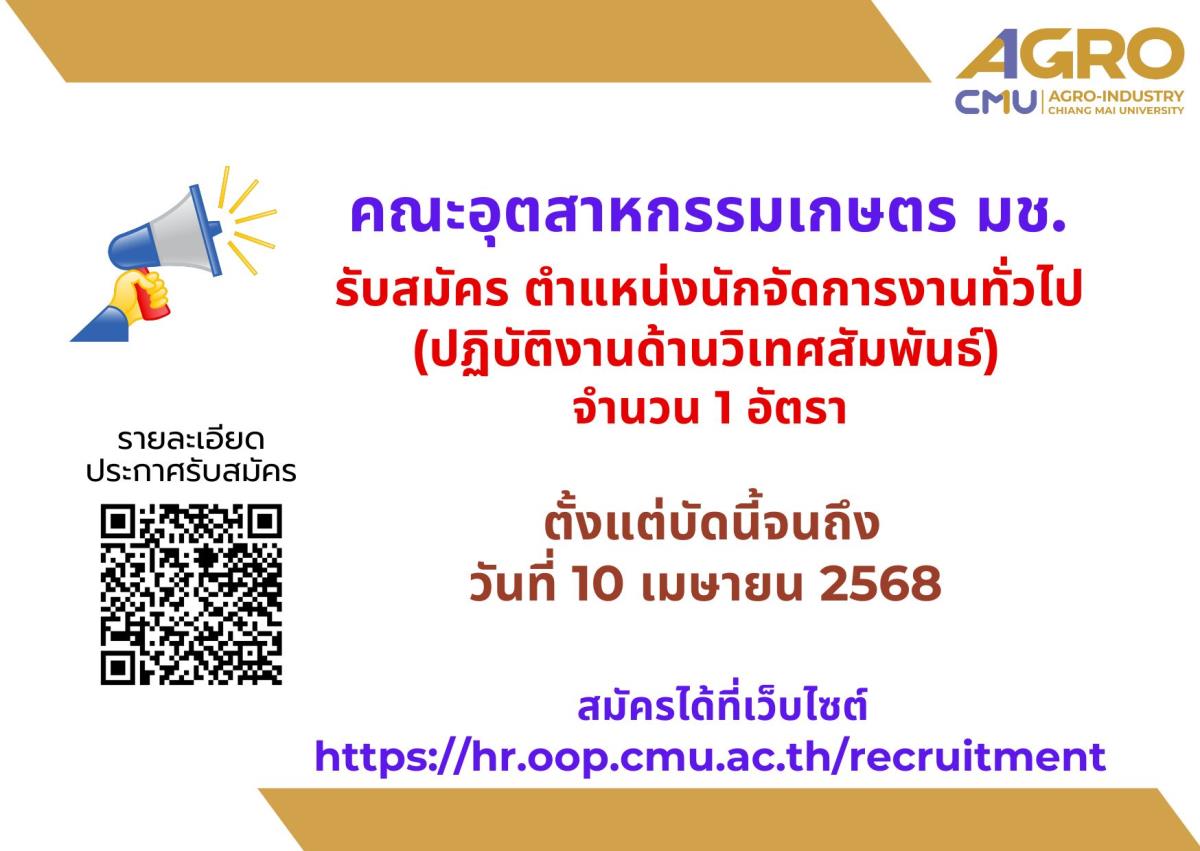
แนะนำงานวิจัย 2024-053: การพัฒนายางคอมโพสิตเสริมแรงจาก ENR และเส้นใยผักตบชวา
การพัฒนายางธรรมชาติอีพอกซิไดซ์ (ENR) ผสมกับเส้นใยผักตบชวา (WHF) เป็นวัสดุเสริมแรง และเติมสารคลอร์เฮกซิดีนกลูโคเนต (CHG) ในปริมาณต่างๆ (1, 5, 10 และ 20 phr) เพื่อเพิ่มคุณสมบัติต้านจุลชีพและการเชื่อมขวางของวัสดุ พบว่าเมื่อเติม CHG 1 phr ค่าความทนแรงดึงเพิ่มขึ้นสูงสุด (4.59 MPa) ขณะที่ CHG 20 phr ให้ความแข็งสูงสุด (38) และช่วยลดช่องว่างภายในโครงสร้างของยาง ค่าการบวมตัวในน้ำมันและโทลูอีนลดลงเมื่อเพิ่ม CHG การวิเคราะห์ด้วย FTIR ยืนยันการเกิดปฏิกิริยาระหว่างหมู่ฟังก์ชันของ CHG และ ENR นอกจากนี้ สูตรผสม ENRC/WHF/CHG ที่ 10 และ 20 phr สามารถยับยั้งแบคทีเรีย Staphylococcus aureus, Escherichia coli และ Bacillus cereus ได้ CHG วัสดุยางคอมโพสิตที่พัฒนาได้จึงเป็นได้ทั้งตัวเชื่อมขวางและสารต้านจุลชีพที่ดี
This study focuses on the development of epoxidized natural rubber (ENR) composites reinforced with water hyacinth fiber (WHF) and incorporating different amounts of chlorhexidine gluconate (CHG) (1, 5, 10, and 20 phr) to enhance antimicrobial properties and crosslinking. The results showed that adding 1 phr of CHG led to the highest tensile strength (4.59 MPa), while 20 phr of CHG provided the highest hardness (38) and reduced internal voids in the rubber structure. Swelling in oil and toluene decreased with increasing CHG content. FTIR analysis confirmed interactions between the functional groups of CHG and ENR. Additionally, ENRC/WHF/CHG composites with 10 and 20 phr effectively inhibited Staphylococcus aureus, Escherichia coli, and Bacillus cereus. The developed rubber composite material demonstrates CHG's dual functionality as both a cross-linking agent and an antimicrobial additive.
Topic: Reinforcement of Epoxidized Natural Rubber with High Antimicrobial Resistance Using Water Hyacinth Fibers and Chlorhexidine Gluconate
Authors: Kanthiya, T.| Rachtanapun, P.| Boonrasri, S.| Kittikorn, T.| Chaiyaso, T.| Worajittiphon, P.| Tanadchangsaeng, N.| Thanakkasaranee, S.| Leksawasdi, N.| Phimolsiripol, Y.| Ruksiriwanich, W.| Jantanasakulwong, K.
Abstract:
In this study, epoxidized natural rubber (ENR) was mixed using a two-roller mixer. Water hyacinth fiber (WHF) acted as a reinforcing agent in the preparation of the rubber composite at 10 phr (ENRC/WHF). Chlorhexidine gluconate (CHG) was added at different concentrations (1, 5, 10, and 20 phr) as an antimicrobial and coupling agent. The tensile strength increased with a CHG content of 1 phr (4.59 MPa). The ENRC/WHF/CHG20 blend offered high hardness (38) and good morphology owing to the reduction in cavities and fiber pull-out from the rubber matrix. The swelling of the sample blends in oil and toluene decreased as the CHG content increased. Reactions of –NH2/epoxy groups and –NH2/–OH groups occurred during the preparation of the ENRC/WHF/CHG blend. The FTIR spectroscopy peak at 1730 cm−1 confirmed the reaction between the −NH2 groups of CHG and epoxy groups of ENR. The ENRC/WHF/CHG blend at 10 phr and 20 phr exhibited zones of inhibition against three bacterial species (Staphylococcus aureus, Escherichia coli, and Bacillus cereus). CHG simultaneously acted as a crosslinking agent between ENR and WHF and as an antimicrobial additive for the blends. CHG also improved the tensile strength, hardness, swelling, and antimicrobial properties of ENR composites.
Keywords: chlorhexidine gluconate; epoxidized natural rubber; water hyacinth fiber
View at publisher: https://www.mdpi.com/2073-4360/16/21/3089
#เทคโนโลยีชีวภาพ #เทคโนโลยีการบรรจุ #เทคโนโลยีผลิตภัณฑ์ทางทะเล #เทคโนโลยีการพัฒนาผลิตภัณฑ์ #วิทยาศาสตร์และเทคโนโลยีการอาหาร #วิศวกรรมกระบวนการอาหาร #นวัตกรรมอุตสาหกรรมเกษตรและการเป็นผู้ประกอบการ #อุตสาหกรรมเกษตร #มหาวิทยาลัยเชียงใหม่ #agrocmu #CMU




